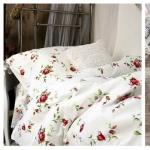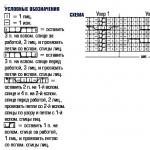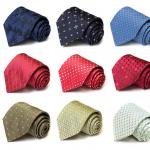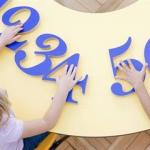What is the silver mirror reaction? Chemical experiment: obtaining a silver mirror Conditions for the reaction of a silver mirror
The experiment with the beautiful effect of the formation of a mirror coating on glass is very visual. This reaction requires experience and patience. In this article you will learn about the necessary and specific preparation of equipment, and also see what reaction equations this process takes place.
The essence of the silver mirror reaction is the formation of metallic silver as a result of a redox reaction during the interaction of an ammonia solution of silver oxide in the presence of aldehydes.
"Silver Mirror" (test tube on the left)To create a durable silver layer you will need:
- glass flask with a capacity of up to 100 ml;
- ammonia solution (2.5-4%);
- silver nitrate (2%);
- aqueous solution of formaldehyde (40%).
Instead of and you can take the ready-made Tollens reagent - ammonia solution silver oxide. To create it, you need to add 1 gram of silver nitrate to 10 drops of water (if the liquid will be stored for a long time, you need to place it in a dark place or in a glass container with dark walls). Immediately before the experiment, the solution (about 3 ml) must be mixed in a 1:1 ratio with a 10% aqueous solution of sodium hydroxide. Silver may precipitate, so it is diluted by slowly adding an ammonia solution. We recommend conducting another spectacular experiment with an ammonia solution and printing a “chemical photograph”.
The reaction is carried out at room temperature. Required condition a successful ending is the perfectly clean and smooth walls of the glass vessel. If there are the slightest particles of contaminants on the walls, the sediment obtained as a result of the experiment will become a loose layer of black or dark gray color.
To clean the flask you need to use different types alkali solutions. So, for processing, you can take a solution, which after cleaning has to be washed off with distilled water. It is necessary to rinse the flask of the cleaning agent many times.
Why is vessel cleanliness so important?
The fact is that the colloidal silver particles formed at the end of the experiment must adhere firmly to the surface of the glass. There should be no fat or mechanical particles on its surface. the water does not contain salts and is ideal for final cleaning of the flask. It can be prepared at home, but it is easier to buy ready-made liquid.
Silver mirror reaction equation:
Ag₂O + 4 NH₃·Н₂О ⇄ 2ОН + 3Н₂О,
where OH is diammine silver hydroxide, obtained by dissolving the metal oxide in an aqueous solution of ammonia.
 Diammine silver complex molecule
Diammine silver complex molecule
Important! The reaction works at low concentrations of ammonia - carefully observe the proportions!
This is how the final stage of the reaction proceeds:
R (any aldehyde)-CH=O + 2OH → 2Ag (precipitated silver colloid) ↓ + R-COONH₄ + 3NH₃ + H₂O
It is better to carry out the second stage of the reaction by carefully heating the flask over the burner flame - this will increase the chances that the experiment will be successful.
What can the reaction of a silver mirror show?
This interesting chemical reaction not only demonstrates certain states of a substance - it can be used to perform a qualitative determination of aldehydes. That is, such a reaction will solve the question: whether there is an aldehyde group in the solution or not.
 General structural formula of aldehydes
General structural formula of aldehydes
For example, in a similar process you can find out whether a solution contains glucose or fructose. Glucose will give a positive result - you will get a “silver mirror”, but fructose contains a ketone group and it is impossible to obtain a silver precipitate. In order to carry out the analysis, instead of a formaldehyde solution, it is necessary to add a 10% glucose solution. Let's look at why and how dissolved silver turns into a solid precipitate:
2OH + 3H₂O + C₆H₁₂O₆ (glucose) = 2Ag↓+ 4NH₃∙H₂O + C₆H₁₂O₇ (gluconic acid is formed).
Let's start with the fact that each class of organic substances has a certain reaction with the help of which its representatives can be distinguished from other substances. The school chemistry course involves studying all high-quality reagents for the main classes of organic substances.
Aldehydes: structural features
Representatives of this class are derivatives of saturated hydrocarbons in which the radical is connected to an aldehyde group. Ketones are isomers of aldehydes. Their similarity lies in their belonging to the class of carbonyl compounds. When performing a task that involves isolating an aldehyde in a mixture, a “silver mirror” reaction will be required. Let us analyze the features of this chemical transformation, as well as the conditions for its implementation. The silver mirror reaction is the reduction process of silver metal from silver diamine(1) hydroxide. In a simplified form, it is possible to write this complex compound in the simplified form of silver oxide (1).
Separation of carbonyl compounds
To form a complex compound, silver oxide is dissolved in ammonia. Considering that the process is a reversible reaction, the silver mirror reaction is performed with a freshly prepared ammonia solution of silver oxide (1). When a complex compound of argentum is mixed with an aldehyde, a redox reaction occurs. The completion of the process is indicated by the precipitation of metallic silver. When the interaction of ethanal and an ammonia solution of silver oxide is carried out correctly, the formation of a silver coating is observed on the walls of the test tube. It was the visual effect that gave this interaction the name “silver mirror”.

Determination of carbohydrates
The reaction of a silver mirror is qualitative to an aldehyde group, so in organic chemistry courses it is also mentioned as a way to recognize carbohydrates such as glucose. Considering the specific structure of this substance, which exhibits the properties of an aldehyde-alcohol, thanks to the “silver mirror” reaction, it is possible to distinguish glucose from fructose. Thus, this is not only a qualitative reaction to aldehydes, but also a way to recognize many other classes of organic substances.

Practical application of the “silver mirror”
It would seem, what difficulties may arise with the interaction of aldehydes and an ammonia solution of silver oxide? You just need to purchase silver oxide, stock up on ammonia and select an aldehyde - and you can safely begin the experiment. But such a primitive approach will not lead the researcher to the desired result. Instead of the expected mirror surface on the walls of the test tube, you will see (at best) a dark brown silver suspension.

The essence of interaction
A high-quality reaction to silver implies adherence to a certain algorithm of actions. Often, even when signs of a mirror layer appear, its quality clearly leaves much to be desired. What are the reasons for such a failure? Is it possible to avoid them? Among the many problems that can lead to undesirable results, there are two main ones:
- violation of the conditions for chemical interaction;
- poor surface preparation for silvering.
During the interaction of the starting substances in the solution, silver cations are formed, combining with the aldehyde group, ultimately forming colloidal small particles of silver. These grains are able to adhere to glass, but can be preserved in solution as a silver suspension. For particle adhesion to occur noble metal with glass, a uniform and durable layer is formed, it is important to pre-degrease the glass. Only if there is a perfectly clean initial surface of the test tube can one count on the formation of a uniform silver layer.
Possible problems
As a major pollutant glassware There is a greasy coating that needs to be gotten rid of. An alkali solution, as well as a hot chrome mixture, will help solve the problem. Next, the test tube is washed with distilled water. If there is no alkali, you can use synthetic agent for dish washing. After degreasing is completed, the glass is washed with a solution of tin chloride and rinsed with water. Distilled water is used to prepare solutions. If it is not available, you can use rainwater. Glucose and formaldehyde are used as reducing agents that allow the precipitation of a pure substance from a solution. With aldehyde it is difficult to count on obtaining a high-quality silver coating, but a monosaccharide (glucose) gives a uniform and durable silver layer on the surface of the mirror.

Conclusion
To silver glass, it is advisable to use silver nitrate. Alkali and ammonia solution are added to the solution of this salt. The condition for a complete reaction and deposition of silver on glass is the creation of an alkaline environment. But if there is an excess of this reagent, side effects. Depending on the chosen experimental technique, a high-quality reaction is obtained by heating. Coloring the solution in Brown color indicates the formation of tiny colloidal particles of silver. Next, a mirror coating appears on the surface of the glass. If the process is successful, the metal layer will be smooth and durable.
Before starting a chemical experiment, it is necessary to find out what the aldehyde is, the presence of which is to be determined. Aldehydes are a group of organic compounds in which the carbon atom has a double bond with an oxygen atom. Each such compound contains a >C=O group. The essence of the reaction is that as a result, metallic silver is formed, which is deposited on the surface. The reaction is carried out with substances containing an aldehyde group in an aqueous solution when heated, in the presence of ammonia. Most often, sugar is used in the reaction, and ordinary sugar is used as the aldehyde. The substance containing ammonia is usually used.You need to be careful when working with silver salts, as they leave black marks. Carry out the experiment wearing gloves.
How does the reaction occur?
?Reagents for the experiment can be found at any pharmacy. Silver nitrate is a lapis pencil. You can also buy formaldehyde and ammonia there. Among other things, you need chemical glassware. The substances you will have to deal with are non-aggressive, but any chemical experiments are best carried out in test tubes and flasks made of chemical glass. Of course, the dishes need to be washed thoroughly. Make an aqueous solution of silver nitrate AgNO3. Add ammonia to it, that is, ammonium hydroxide NH4OH. You form silver oxide Ag2O, which precipitates as a brown precipitate. The solution then becomes clear and an OH complex is formed. It is he who acts on the aldehyde during the redox reaction, which results in the formation of an ammonium salt. The formula for this reaction looks like this: R-CH=O + 2OH --> RCOONH4 + 2Ag +3NH3 + H2O. If you leave a glass rod or plate in the jar during the reaction, after about a day it will become covered with a shiny layer. The same layer is formed on the walls of the vessel.
The reaction can be written in a simplified way: R-CH=O + Ag2O --> R-COOH + 2Ag.
How mirrors were made
Before the advent of the sputtering method, the reaction of a silver mirror was the only way obtaining mirrors on glass and porcelain. Currently, this method is used to obtain a conductive layer on glass, ceramics and other dielectrics. This technology is used to create coated optics for photographic lenses, telescopes, etc.Laboratory work No. 5
Propertiescarbohydrates
Experiment 1. Reaction of a silver mirror is a recovery reaction silver from ammonia solution silver oxide (Tollens reagent).
In aqueous solution ammonia silver oxide dissolves to form a complex compound - diamminesilver(I) hydroxide OH
when added to which aldehyde a redox reaction occurs to form metallic silver:
If the reaction is carried out in a vessel with clean and smooth walls, then the silver precipitates in the form of a thin film, forming a mirror surface.
In the presence of the slightest contamination, silver is released in the form of a gray loose sediment.
The "silver mirror" reaction can be used as a qualitative reaction for aldehydes. Thus, the “silver mirror” reaction can be used as a distinctive one between glucose And fructose. Glucose is an aldose (contains an aldehyde group in an open form), and fructose is a ketose (contains a keto group in an open form). Therefore, glucose gives a “silver mirror” reaction, but fructose does not. But if an alkaline medium is present in the solution, then ketoses isomerize into aldoses and also give positive reactions with an ammonia solution silver oxide (Tollens reagent).
Qualitative reaction of glucose with an ammonia solution of silver oxide. The presence of an aldehyde group in glucose can be proven using an ammonia solution of silver oxide. Add glucose solution to the ammonia solution of silver oxide and heat the mixture in a water bath. Soon metallic silver begins to deposit on the walls of the flask. This reaction is called the silver mirror reaction. It is used as a quality compound for the discovery of aldehydes. The aldehyde group of glucose is oxidized to a carboxyl group. Glucose is converted to gluconic acid.
CH 2 HE – (SNON) 4 – SLEEP +Ag 2 O= CH 2 HE – (SNON) 4 – COOH + 2Ag↓

The order of work.
2 ml is poured into two test tubes. ammonia solution of silver oxide. Add 2 ml to one of them. 1% glucose solution, the other - fructose. Both test tubes are boiling.
An ammonia solution of silver oxide hydrate is obtained by reacting silver nitrate with sodium hydroxide and ammonium hydroxide:
AgNO3+ NaOH → AgOH↓+ NaNO3,
AgOH + 2 NH4 OH→[ Ag(NH3)2] OH + H2O,
ammonia solution
OH + 3 H2→ Ag2O + 4 NH4 OH.
Principle of the method. A mirror is formed on the walls of the test tube with glucose as a result of the release of metallic silver.
Design of the work: Write the conclusion, as well as the course and equations of the reaction in a notebook.
Experiment 3. Qualitative reaction to fructose
Principle of the method. When heating a sample containing fructose in the presence resorcinol And of hydrochloric acid up to 80 o C after some time a bright red color appears in the test tube with fructose.
When heating a sample containing fructose in the presence resorcinol And of hydrochloric acid a cherry-red color appears. The sample is also applicable to detect other ketosis. Aldose under the same conditions, they interact more slowly and give a pale pink color or do not interact at all. Open F. F. Selivanov in 1887. Used for urine analysis. The test is positive for fructosuria of metabolic or transport origin. In 13% of cases, the test is positive with a food load of fruits and honey. Chem. formula fructose – C 6 H 12 O 6

Cyclic formula of fructose
Acyclic form 
fructose
Painted connection
R- residues
hydroxymethylfurfural
The order of work.
2 ml are poured into two test tubes: into one - a 1% glucose solution, into the other - a 1% fructose solution. 2 ml of Selivanov’s reagent are added to both test tubes: 0.05 g of resorcinol is dissolved in 100 ml of 20% hydrochloric acid. Both test tubes are carefully heated to 80 o C (before boiling). A red color appears.

Conclusions: the results of the experiment and the reaction equation are written down in a notebook.
Let's continue the topic of chemical experiments, because we hope that you will definitely like them. This time we present to your attention another fascinating experience, during which we will receive a silver mirror.
Let's start by watching the video
We will need:
- capacity;
- silver nitrate;
- hot water;
- ammonia solution 10%;
- glucose;
- alcohol burner

Let's start with silver nitrate. Take about a gram of it and dilute it in a small amount hot water.

Next, add sodium hydroxide to the resulting solution. During this reaction, silver oxide is formed, which precipitates.

Next, add a 10 percent ammonia solution to the silver oxide precipitate. The ammonia solution must be added until the precipitate dissolves.

During this reaction, silver ammonia is formed. Add 5 grams of glucose to the resulting solution.

Now you need to heat the resulting mixture. To do this, light the alcohol burner and place the glass on it so that the mixture gradually heats up. During this reaction, very much is released a large number of ammonia, so this reaction must be carried out either under a hood or outside. The reaction can also produce silver nitrite, which is very dangerous substance, so the dishes must be washed thoroughly after the reaction.


After some time, a thin layer of silver gradually begins to settle on the walls of the glass. The reaction is completed approximately 15 minutes after heating begins.


In order to get a more even layer of silver, you need to put a glass with the mixture in a large container, pour hot water into the container and place it on an alcohol burner. The temperature will thus be distributed evenly and the result will be more effective.






